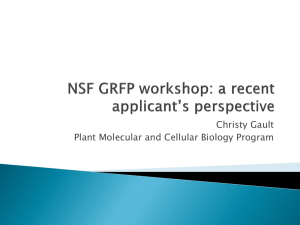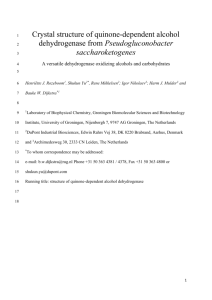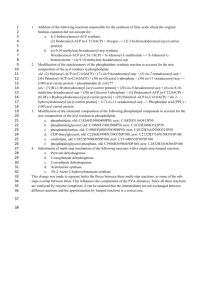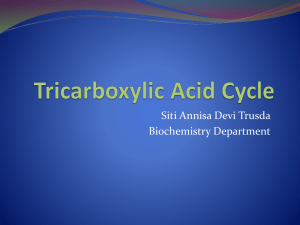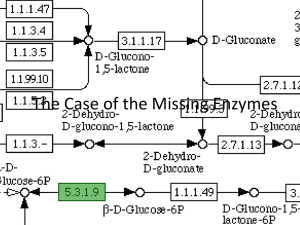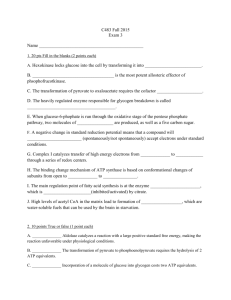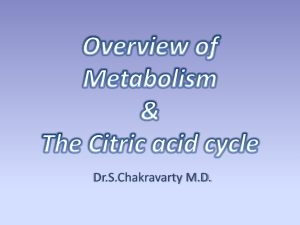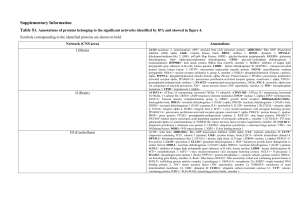file - BioMed Central
advertisement
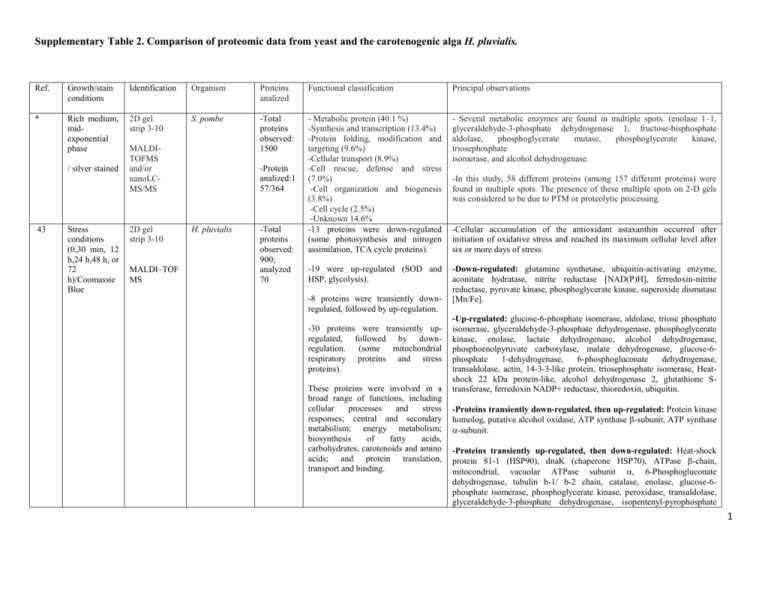
Supplementary Table 2. Comparison of proteomic data from yeast and the carotenogenic alga H. pluvialis. Ref. Growth/stain conditions Identification Organism Proteins analized Functional classification Principal observations * Rich medium, midexponential phase 2D gel strip 3-10 S. pombe -Total proteins observed: 1500 - Metabolic protein (40.1 %) -Synthesis and transcription (13.4%) -Protein folding, modification and targeting (9.6%) -Cellular transport (8.9%) -Cell rescue, defense and stress (7.0%) -Cell organization and biogenesis (3.8%) -Cell cycle (2.5%) -Unknown 14.6% -13 proteins were down-regulated (some photosynthesis and nitrogen assimilation, TCA cycle proteins). - Several metabolic enzymes are found in multiple spots. (enolase 1–1, glyceraldehyde-3-phosphate dehydrogenase 1, fructose-bisphosphate aldolase, phosphoglycerate mutase, phosphoglycerate kinase, triosephosphate isomerase, and alcohol dehydrogenase. -19 were up-regulated (SOD and HSP, glycolysis). -Down-regulated: glutamine synthetase, ubiquitin-activating enzyme, aconitate hydratase, nitrite reductase [NAD(P)H], ferredoxin-nitrite reductase, pyruvate kinase, phosphoglycerate kinase, superoxide dismutase [Mn/Fe]. / silver stained 43 Stress conditions (0,30 min, 12 h,24 h,48 h, or 72 h)/Coomassie Blue MALDITOFMS and/or nanoLCMS/MS 2D gel strip 3-10 MALDI–TOF MS -Protein analized:1 57/364 H. pluvialis -Total proteins observed: 900; analyzed 70 -8 proteins were transiently downregulated, followed by up-regulation. -30 proteins were transiently upregulated, followed by downregulation. (some mitochondrial respiratory proteins and stress proteins). These proteins were involved in a broad range of functions, including cellular processes and stress responses; central and secondary metabolism; energy metabolism; biosynthesis of fatty acids, carbohydrates, carotenoids and amino acids; and protein translation, transport and binding. -In this study, 58 different proteins (among 157 different proteins) were found in multiple spots. The presence of these multiple spots on 2-D gels was considered to be due to PTM or proteolytic processing. -Cellular accumulation of the antioxidant astaxanthin occurred after initiation of oxidative stress and reached its maximum cellular level after six or more days of stress. -Up-regulated: glucose-6-phosphate isomerase, aldolase, triose phosphate isomerase, glyceraldehyde-3-phosphate dehydrogenase, phosphoglycerate kinase, enolase, lactate dehydrogenase, alcohol dehydrogenase, phosphoenolpyruvate carboxylase, malate dehydrogenase, glucose-6phosphate 1-dehydrogenase, 6-phosphogluconate dehydrogenase, transaldolase, actin, 14-3-3-like protein, triosephosphate isomerase, Heatshock 22 kDa protein-like, alcohol dehydrogenase 2, glutathione Stransferase, ferredoxin NADP+ reductase, thioredoxin, ubiquitin. -Proteins transiently down-regulated, then up-regulated: Protein kinase homolog, putative alcohol oxidase, ATP synthase -subunit, ATP synthase -subunit. -Proteins transiently up-regulated, then down-regulated: Heat-shock protein 81-1 (HSP90), dnaK (chaperone HSP70), ATPase -chain, mitocondrial, vacuolar ATPase subunit , 6-Phosphogluconate dehydrogenase, tubulin b-1/ b-2 chain, catalase, enolase, glucose-6phosphate isomerase, phosphoglycerate kinase, peroxidase, transaldolase, glyceraldehyde-3-phosphate dehydrogenase, isopentenyl-pyrophosphate 1 isomerase, phosphatase PP1, superoxide dismutase [Cu–Zn], NADHplastoquinone oxidoreductase. ** Rich medium, midexponential phase was subjected to oxidative stress H2O2/DIGE 2D gel strip 4-7 S. pombe MALDI-MS -Total proteins observed: ND; analyzed : 110 Proteins were involved in a broad range of functions, including cellular processes and stress response; central and secondary metabolism; energy metabolism; biosynthesis of fatty acids, carbohydrates, carotenoids and amino acids; and protein translation, transport and binding. Down-regulated (51/110 proteins): ATPase, ubiquitin-activating enzyme, 3-isopropylmalate dehydratase, HSP70, HSP90, DNAK-type molecular, Vtype ATPase, t-complex protein 1, phosphoglucomutase, precursor of GMP synthase, malate oxidoreductase [NAD], glucose-6-phosphate dehydrogenase, malate oxidoreductase, hexokinase, mitochondrial F1ATPase , putative pyruvate kinase, putative sugar oxidoreductase, hexokinase 2, glycerol 3-phosphate dehydrogenase, actin, glutamine synthetase, aldo/keto reductase, thioredoxin reductase, peroxiredoxin. Up-regulated (59/110): Probable ATP binding protein, pyruvate decarboxylase, HSP70, putative pyruvate decarboxylase, enolase, putative phosphoglycerate dehydrogenase, 6- phosphogluconate dehydrogenase, glyceraldehyde-3-phosphate dehydrogenase, alcohol dehydrogenase, 3isopropylmalate dehydrogenase, fructose-bisphosphate aldolase , enolase, 40S ribosomal protein S5. 25 Rich medium, midexponential phase was subjected to oxidative stress H2O2/DIGE 2D gel strip 3-10 and 4-7 S. pombe MALDI MS -Total proteins observed: 1040; analyzed: 158 -57% of differentially regulated proteins corresponded to four functional groups; glycolysis (19%), amino acid metabolism (16%), molecular chaperones (11%) and protein synthesis (11%). -11% were of unknown function. -The remaining 32% represented 15 different functional categories. -Proteins involved in glycolysis represented the largest functional group, with 50 isoform entries (14 gene products). Enzymes in the upper half of the pathway were upregulated, while those in the lower half were down-regulated. *** YPD medium, exponential growth phase (5, 15, 30, or 60 min after addition of H2O2 or 2D gel strip 3-10 MALDI-TOF MS C. albicans -Total proteins observed: ND; analyzed: 52 -32 oxidoreductases were identified. Proteins were involved in a broad range of functions, including ROS detoxification, C-compound and carbohydrate metabolism, amino acid metabolism, oxidoreduction, chaperones, nucleotide metabolism, Down-regulated : Alcohol dehydrogenase 1, enolase, fructose 1,6bisphosphate aldolase, hexokinase 1,phosphoglucomutase precursor, pyruvate dehydrogenase, phosphoglycerate kinase, 2-hydroxy acid dehydrogenase, acetolactate synthase, hydroxymethylglutaryl-CoA synthase, NADP-specific glutamate dehydrogenase, ornithine aminotransferase, Ade1, min4, phosphoribosyl amine glycine, adenylosuccinate synthetase, hsc1, sks2, HSP 70 family, ssc1, ssp1, F1ATP synthase, ribose 5-phosphate isomerase. Up-regulated: Glyceraldehyde-3-phosphate dehydrogenase 1, Pfk1, 6phosphofructokinase, pyruvate kinase, aldo/keto reductase , dihydroxyacetone kinase 1, dak1, glucose-6-phosphate 1-dehydrogenase, zwf1, glutamine synthetase, glutamate-ammonia ligase, glycerol-3phosphate dehydrogenase, malate dehydrogenase, phosphoglucomutase precursor, phosphoglycerate dehydrogenase, transaldolase, transketolase , catalase, glutathione S-transferase 2, thioredoxin peroxidase, vacuolar ATP synthase catalytic subunit , succinate semialdehyde dehydrogenase (predicted), zinc-binding dehydrogenase, T-complex protein 1, alpha subunit. Down-regulated : -Amino acid metabolism (4): Pentafunctional enzyme, putative sulfite reductase,histidine biosynthesis trifunctional protein, cysteine synthase. -C-compound and carbohydrate metabolism (9): Aconitate hydratase, citrate synthase, aldohexose-specific glucokinase, hexokinase II, pyruvate 2 diamide/ silver nitrate protein synthesis and other. dehydrogenase, 6-phosphofructokinase, pyruvate carboxylase 2, UTPglucose-1-phosphate uridylyltransferase. -Nucleotide metabolism (2): Adenylosuccinate phosphoribosylformyl glycinamidine synthetase. synthetase, 5- -Protein synthesis (13): Protein of the 40S ribosomal subunit, aspartyltRNA synthetase, cysteinyl-tRNA synthetase, methionyl-tRNA synthetase. -Other (12): Acetyl-coenzyme-A hydrolase, F1F0-ATPase complex, F1 subunit, stress protein, probable quinone oxidoreductase, nuclear pore protein, ABC transporter, oxidoreductase, DnaK-type molecular chaperone. Up-regulated: -ROS detoxification (8): Cadmium-induced protein, catalase A, glutathione reductase, glutathione peroxidase, TSA/alkyl hydroperoxide peroxidase C (AhPC) family, putative alkyl hydroperoxide reductase, GST, thioredoxin reductase. -Oxidoreductases (8): NADPH dehydrogenase, putative reductase, potential zinc-binding dehydrogenase, alcohol dehydrogenase, putative NADH-dependent flavin oxidoreductase. -Chaperones (5): Heat shock protein, HSP70 family. -Other (11): D-Arabinose dehydrogenase, argininosuccinate synthetase, GTP-binding protein, putative esterase, mitochondrial respiratory function protein, serine hydroxymethyltransferase precursor, mitocondrial stressinduced protein. 31 24 YEPD medium, exponentially growing. To induce apoptosis, H2O2 was added and cells were collected after 3 h/ silver staining 2D gel strip 3-10 YPD medium, 2D gel S. cerevisiae MALDI-TOF MS and ESIIT MS C. albicans -Total proteins observed: 2000; analyzed: 31 The differentially expressed proteins were sorted into the following functional groups: fermentative pathway (4), glycolysis (14), amino acid and pyrimidine metabolism (4), heat shock (3), and others (6). Exposure of yeast cells to non-physiological doses of peroxides decreases the expression (or increases the degradation) of enzymes involved in protecting against oxidative stress leading to a reduced level of antioxidant defense and making the cells more prone to apoptosis. -Total -50 The stationary-phase signature revealed a complex reprogramming of most abundant proteins on Down-regulated: Enolase 2, triosephosphate isomerase, glyceraldehyde-3phosphate dehydrogenase 2-3, homoserine dehydrogenase, alcohol dehydrogenase I, peroxiredoxin. Up-regulated: Transketolase 1, pyruvate decarboxylase 1, homocitrate synthase, heat shock protein 75, pyruvate kinase 1, enolase 2, fructosebisphosphate aldolase, 3-isopropylmalate dehydratase, glyceraldehyde-3phosphate dehydrogenase 3, mannose-1-phosphate guanyltransferase, cytocrome c oxidase, heat shock protein SSA2. 3 exponential and stationary growth phase/ silver or colloidal Coomassie stained strip 3-10 MALDI-TOF MS proteins observed: ND; analyzed: 360 colloidal Coomassie stained 2-D gels in exponential and stationary growth. metabolic networks. Up-regulation of the glyoxylate cycle, gluconeogenesis and glutamate degradation signal a switch to the utilization of alternative carbon sources instead of the exhausted glucose. The induction of proteins involved in defending against oxidative and heat stress indicates a change in the redox balance and in the concentrations of reactive oxygen species. Exponential phase: -Amino acid metabolism (4/4): Ornithine aminotransferase, ketol-acid reducto-isomerase, threonine synthase. -C-compound and carbohydrate metabolism (9/29): Aconitate hydratase, alcohol dehydrogenase, acetyl-coenzyme-A synthetase, fructosebisphosphate aldolase, 6-phosphogluconate dehydrogenase, NAD-isocitrate dehydrogenase, pyruvate dehydrogenase, phosphomannomutase, transaldolase. -Cell rescue, defense and virulence: (4/11): Likely thioredoxin peroxidase, ubiquitin-activating enzyme. -Energy (3/6): NADH-cytochrome-b5 reductase, dihydrolipoamide dehydrogenase. -Protein fate (6/6): Aminopeptidase yscII, microsomal ATPase, HSP70 family. -Protein synthesis (5/6): Protein of the 40S ribosomal subunit, ribosomal protein L10. -Other (8/10): Actin, adenosine kinase, likely metallopeptidase, Sadenosyl-L-homocysteine hydrolase. Stationary phase: -C-compound and carbohydrate metabolism (20): Alcohol dehydrogenase, alcohol dehydrogenase I, pyruvate kinase, citrate synthase, enolase I, fructose-bisphosphate aldolase, glyceraldehyde-3-phosphate dehydrogenase, aldohexose-specific glucokinase, phosphoglycerate mutase, isocitrate lyase, mitochondrial malate dehydrogenase precursor, pyruvate decarboxylase, glucose-6-phosphate isomerase, phosphoglycerate kinase, transketolase 1. -Cell rescue, defense, and virulence: (7/11): superoxide dismutase, HSP70. Stress protein, HSP60, -Energy (3/6): NAD-aldehyde dehydrogenase, ATPase F1 subunit. -Other (2/10): Acetyl-coenzyme-A hydrolase, unknown function. 4 This study MM glucose 2%, lag, exponential and stationary phase/ Coomassie stained 2D gel strip 3-10 MALDI-TOF MS X. dendrorhous -Total proteins observed: 600; analyzed: 131 -Genetic information processing (25%) -Environmental information processing (5%) -Cellular processes (13%) -Unknown 8% -Metabolism proteins (49 %), consisting of the following subgroups: -carbohydrate (13%), redox (8%), amino acid (11%), energy metabolism (2%), lipid (5%), carotenoid biosynthesis (6%), other (5%). -Prior to carotenogenesis, enzymes related to acetyl-CoA synthesis were present at higher abundances. Later, redox- and stress- related proteins were up-regulated during the induction of carotenogenesis. For the carotenoid biosynthetic enzymes mevalonate kinase and phytoene/squalene synthase, we observed higher abundances during the induction and/or accumulation of carotenoids. -The most abundant proteins found in this study were involved in metabolic pathways and were present in multiple spots. -The expression patterns of carbohydrate and lipid metabolism proteins demonstrated a tight regulation of substrates for cellular metabolism. -Redox proteins were up-regulated to contribute to late stage astaxanthin synthesis reactions. Ref., reference. * Hwang KH, Carapito C, Böhmer S, Leize E, Van Dorsselaer A, Bernhardt R: Proteome analysis of Schizosaccharomyces pombe by twodimensional gel electrophoresis and mass spectrometry. Proteomics 2006, 6:4115-29. ** Weeks ME, Sinclair J, Jacob RJ, Saxton MJ, Kirby S, Jones J, Waterfield MD, Cramer R, Timms JF: Stress-induced changes in the Schizosaccharomyces pombe proteome using two-dimensional difference gel electrophoresis, mass spectrometry and a novel integrated robotics platform. Proteomics 2005, 5:1669-85. *** Kusch H, Engelmann S, Albrecht D, Morschhäuser J, Hecker M: Proteomic analysis of the oxidative stress response in Candida albicans. Proteomics 2007, 7:686-97. 5
